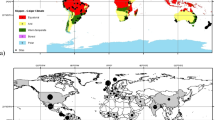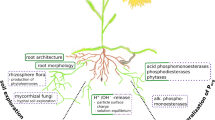Abstract
In the Serengeti National Park, Tanzania, precipitation and soil nitrogen vary greatly between northwestern tallgrass areas and southeastern shortgrass areas, with the tallgrass having higher total precipitation and lower soil fertility. We used a model of grassland productivity, carbon/nitrogen cycling, and abiotic factors to test the hypothesis that tallgrass productivity is limited primarily by nitrogen availability while shortgrass productivity is limited by water. Under observed grazing intensities and ungrazed conditions, precipitation exerted primary control over grassland productivity for both regions, with differences in soil texture mediating soil water availability to the grasses. Mineral nitrogen availability interacted with water availability to influence productivity at precipitation levels ⩾ 130% of the mean. Nitrogen mineralization and precipitation were positively related for each grassland type, however, nitrification varied both between grassland types and between grazed and ungrazed conditions. Combined mineralization and nitrification could not maintain soil mineral nitrogen levels in the face of plant nitrogen uptake stimulated by increased precipitation, thus providing the mechanism by which nitrogen becomes a secondary limiting factor for both grasslands. Model experiments indicated that the pattern of primary limitation by precipitation and secondary limitation by nitrogen was robust to model assumptions concerning ungulate deposition of urine and dung nitrogen to the soil.
Similar content being viewed by others
References
Anonymous (1990) SURFER Version 4. Golden Software, Inc. Golden, CO
Bell RHV (1992) The effect of soil nutrient availability on community structure in African ecosystems. In: Huntley BH & Walker BH (Eds) Ecology of Tropical Savannas (pp 193–216). Springer-Verlag, New York
Birch HF (1958) The effect of soil drying on humus decomposition and nitrogen availability. Plant and Soil 10: 9–32
Birch HF (1960) Nitrification in soils after different periods of dryness. Plant and Soil 12: 81–96
Birch HF & Friend MT (1956) The organic-matter and nitrogen status of East African soils. Journal of Soil Science 7: 156–167
Chapin FS III, Bloom A, Field CB & Waring RH (1987) Plant responses to multiple environmental factors. BioScience 37: 49–57
Coe MJ, Cumming DH & Phillipson J (1976) Biomass and production of large African herbivores in relation to rainfall and primary production. Oecologia 22: 341–354
Cole MM (1986) The Savannas: Biogeography and Geobotany. Academic, New York
Corbet ES & Crouse RP (1968) Rainfall Interception by Annual Grass and Chaparral. U.S. Forest Service Research Paper PSW-48
Coughenour MB (1984) A mechanistic simulation analysis of water use, leaf angles, and grazing in East African graminoids. Ecological Modelling 26: 203–230
Coughenour MB, McNaughton SJ & Wallace LL (1984) Modelling primary production of perennial graminoids — uniting physiological processes and morphometric traits. Ecological Modelling 23: 101–134
Coughenour MB, McNaughton SJ & Wallace LL (1984b) Simulation study of East-African perennial graminoid responses to defoliation. Ecological Modelling 26: 177–201
Coughenour MB, McNaughton SJ & Wallace LL (1985) Responses of an African graminoid (Themeda triandra Forsk.) to frequent defoliation, nitrogen, and water — a limit of adaptation to herbivory. Oecologia 68: 105–110
Coupland RT (1958) The effects of fluctuations in weather upon the grasslands of the Great Plains. Botanical Review 24: 274–317
Deshmukh I (1984) A common relationship between precipitation and grassland peak biomass for East and southern Africa. African Journal of Ecology 22: 181–186
Donaldson CH, Rootman G & Grossmann D (1984) Long term nitrogen and phosphorus application to veld. Journal of the Grassland Society of South Africa 1: 27–32
Dye PJ & Spear PT (1982) The effect of bush clearing and rainfall variability on grass yield and composition in south-west Zimbabwe. Zimbabwe Journal of Agricultural Research 20: 103–117
Gardner WR (1960) Dynamic aspects of water availability to plants. Soil Science 89: 63–73
Haynes RJ (1986) The decomposition process: mineralization, immobilization, humus formation, and degradation. In: Haynes RJ (Ed) Mineral Nitrogen in the Plant-Soil System (pp 52–126). Academic, Orlando
Holland EA, Parton WJ, Detling JK & Coppock DL (1992) Physiological responses of plant populations to herbviory and their consequences for ecosystem nutrient flow. American Naturalist 140: 685–706
Keya NCO (1973) The effect of N and P fertilizers on the productivity of Hyparrhenia grasslands. East African Agronomy and Forestry Journal 39: 195–200
Lauenroth WK & Sala OE (1992) Long-term forage production of North American shortgrass steppe. Ecological Applications 2: 397–403
Maddock L (1979) The ‘migration’ and grazing succession. In: Sinclair ARE & Norton-Griffiths M (Eds) Serengeti: Dynamics of an Ecosystem (pp 104–). University of Chicago, Chicago
McCown RL, Gillard P & Edye LA (1974) The annual variation in yield of pastures in the seasonally dry tropics of Queensland. Australian Journal of Experimental Agriculture and Animal Husbandry 14: 328–333
McGill WB, Hunt HW, Woodmansee RG & Ruess JO (1981) PHOENIX, a model of the dynamics of carbon and nitrogen in grassland soils. In: Clark FE & Rosswall T (Eds) Terrestrial Nitrogen Cycles (pp 49–115). Royal Swedish Academy of Science, Stockholm
McNaughton SJ (1983) Serengeti grassland ecology: the role of composite environmental factors and contingency in community organization. Ecological Monographs 53: 291–320
McNaughton SJ (1985) Ecology of a grazing ecosystem: the Serengeti. Ecological Monographs 55: 259–294
McNaughton SJ (1990) Mineral nutrition and seasonal movements of African migratory ungulates. Nature 345: 613–615
McNaughton SJ, Ruess RW & Seagle SW (1988) Large mammals and process dynamics in African ecosystems. BioScience 38: 794–800
Munn RE (1966) Descriptive Micrometeorology. Academic, New York
Noy-Meir I (1973) Desert ecosystems: environment and producers. Annual Review of Ecology and Systematics 4: 25–51
O'Connor TG (1985) A Synthesis of Field Experiments Concerning the Grass Layer in the Savanna Regions of Southern Africa. South African National Scientific Programmes Report No. 114. Council for Scientific and Industrial Research, Pretoria
Parton WJ (1978) Abiotic section of ELM. In Innis GI (Ed) Grassland Simulation Model (pp 31–). Springer-Verlag, New York
Paul EA & Clark FE (1989) Soil Microbiology and Biochemistry. Academic, San Diego
Penning de Vries FWT, Keul JM & van Keulen H (1980) Productivity of Sahelian rangelands in relation to the availability of nitrogen and phosphorus in the soil. In: Rosswall T (Ed) Nitrogen Cycling in West African Ecosystems (pp 95–113). Royal Swedish Academy of Science,Stockholm
Pennycuick L (1975) Movements of migratory wildebeest population in the Serengeti area between 1960 and 1973. East African Wildlife Journal 13: 65–87
Ruess RW (1984) Nutrient movement and grazing: experimental effects of clipping and nitrogen source on nutrient uptake in Kyllinga nervosa. Oikos 43: 183–188
Ruess RW & McNaughton SJ (1984) Urea as a promotive coupler of plant-herbivore interactions. Oecologia 63: 331–337
Ruess RW & McNaughton SJ (1987) Grazing and the dynamics of nutrient and energy regulated microbial processes in the Serengeti grasslands. Oikos 49: 101–110
Ruess RW & McNaughton SJ (1988) Ammonia volatilization and the effects of large grazing mammals on nutrient loss from East African grasslands. Oecologia 77: 382–386
Ruess RW, McNaughton SJ & Coughenour MB (1983) The effects of clipping, nitrogen source and nitrogen concentration on the growth responses and nitrogen uptake of an East African sedge. Oecologia 59: 253–261
Ruess RW & Seagle SW. Landscape patterns in soil microbial processes in the Serengeti National Park, Tanzania. Ecology (in press)
Sala OE, Parton WJ, Joyce LA & Lauenroth WK (1988) Primary productivity of the central grassland region of the United States. Ecology 69: 40–45
Seagle SW, McNaughton SJ & Ruess RW (1992) Simulated effects of grazing on soil nitrogen and mineralization in contrasting Serengeti grasslands. Ecology 73: 1105–1123
Seagle SW & McNaughton SJ (1992) Spatial variation in forage nutrient concentrations and the distribution of Serengeti grazing ungulates. Landscape Ecology 7: 229–241
Sims PL, Singh JS & Lauenroth WK (1978) The structure and function of ten western North American grasslands. I. Abiotic and vegetational characteristics. Journal of Ecology 66: 251–285
Tinely KL (1982) The influence of soil moisture balance on ecosystem patterns in Southern Africa. In: Huntley BJ & Walker BH (Eds) Ecology of Tropical Savannas (pp 175–192). Springer-Verlag, New York
Toft NL, McNaughton SJ & Geogiadis NJ (1987) Effects of water stress and simulated grazing on leaf elongation and water relations of an East African grass, Eustachys paspaloides. Australian Journal of Plant Physiology 14: 211–226
Walker BH (Ed) (1987) Determinants of Tropical Savannas. IUBS Monograph Series No. 3 IRL Press Ltd., Oxford
Author information
Authors and Affiliations
Rights and permissions
About this article
Cite this article
Seagle, S.W., McNaughton, S.J. Simulated effects of precipitation and nitrogen on Serengeti grassland productivity. Biogeochemistry 22, 157–178 (1993). https://doi.org/10.1007/BF00000645
Received:
Accepted:
Issue Date:
DOI: https://doi.org/10.1007/BF00000645




